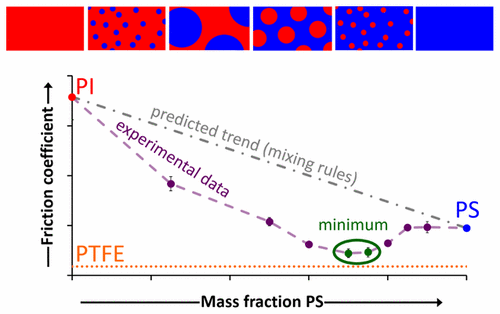当前位置:
X-MOL 学术
›
ACS Appl. Mater. Interfaces
›
论文详情
Our official English website, www.x-mol.net, welcomes your
feedback! (Note: you will need to create a separate account there.)
Unexpected Tribological Synergy in Polymer Blend Coatings: Leveraging Phase Separation to Isolate Domain Size Effects and Reduce Friction
ACS Applied Materials & Interfaces ( IF 8.3 ) Pub Date : 2017-09-25 00:00:00 , DOI: 10.1021/acsami.7b10170 Jillian A. Emerson 1 , Nikolay T. Garabedian 2 , Axel C. Moore 3 , David L. Burris 2 , Eric M. Furst 1 , Thomas H. Epps 1, 4
ACS Applied Materials & Interfaces ( IF 8.3 ) Pub Date : 2017-09-25 00:00:00 , DOI: 10.1021/acsami.7b10170 Jillian A. Emerson 1 , Nikolay T. Garabedian 2 , Axel C. Moore 3 , David L. Burris 2 , Eric M. Furst 1 , Thomas H. Epps 1, 4
Affiliation

|
We employed a systematic processing approach to control phase separation in polymer blend thin films and significantly reduce dynamic friction coefficients (μ)s. We leveraged this modulation of phase separation to generate composite surfaces with dynamic friction coefficients that were substantially lower than expected on the basis of simple mixing rules, and in several cases, these friction coefficients were lower than those of both pure components. Using a model polyisoprene [PI]/polystyrene [PS] composite system, a minimum μ was found in films with PS mass fractions between 0.60 and 0.80 (μblend = 0.11 ± 0.03); that value was significantly lower than the friction coefficient of PS (μPS = 0.52 ± 0.01) or PI (μPI = 1.3 ± 0.09) homopolymers and was comparable to the friction coefficient of poly(tetrafluoroethylene) [PTFE] (μPTFE = 0.09 ± 0.01) measured under similar conditions. Additionally, through experiments in which the domain size was systematically varied at constant composition (through an annealing process), we demonstrated that μ decreased with decreasing characteristic domain size. Thus, the tribological synergy between PS and PI domains (discrete size, physical domain isolation, and overall film composition) was shown to play an integral role in the friction and wear of these PS/PI composites. Overall, our results suggest that even high friction polymers can be used to create low friction polymer blends by following appropriate design rules and demonstrate that engineering microstructure is critical for controlling the friction and adhesion properties of composite films for tribologically relevant coatings.
中文翻译:

聚合物共混涂层中的意外摩擦协同作用:利用相分离来隔离域尺寸效应并减少摩擦
我们采用了系统的处理方法来控制聚合物共混物薄膜中的相分离,并显着降低动态摩擦系数(μ)s。我们利用这种相分离的调制来生成复合表面,该表面的动态摩擦系数大大低于根据简单混合规则得出的预期值,并且在某些情况下,这些摩擦系数均低于两个纯组分的摩擦系数。使用模型聚异戊二烯[PI] /聚苯乙烯[PS]复合系统,最小μ与PS质量分数膜被发现0.60和0.80之间(μ共混物= 0.11±0.03); 该值比显著PS的摩擦系数(μ降低PS = 0.52±0.01)或PI(μ PI= 1.3±0.09)均聚物和比得上聚(四氟乙烯的摩擦系数)[PTFE](μ PTFE= 0.09±0.01)在类似条件下测得。此外,通过在恒定组成下(通过退火过程)系统地改变畴尺寸的实验,我们证明μ随着特征畴尺寸的减小而减小。因此,显示了PS和PI域之间的摩擦学协同作用(离散尺寸,物理域隔离和整个膜成分)在这些PS / PI复合材料的摩擦和磨损中起着不可或缺的作用。总体而言,我们的结果表明,遵循适当的设计规则,即使是高摩擦力的聚合物也可用于生产低摩擦力的聚合物共混物,并证明工程微观结构对于控制摩擦学相关涂料的复合膜的摩擦和粘附性能至关重要。
更新日期:2017-09-25
中文翻译:

聚合物共混涂层中的意外摩擦协同作用:利用相分离来隔离域尺寸效应并减少摩擦
我们采用了系统的处理方法来控制聚合物共混物薄膜中的相分离,并显着降低动态摩擦系数(μ)s。我们利用这种相分离的调制来生成复合表面,该表面的动态摩擦系数大大低于根据简单混合规则得出的预期值,并且在某些情况下,这些摩擦系数均低于两个纯组分的摩擦系数。使用模型聚异戊二烯[PI] /聚苯乙烯[PS]复合系统,最小μ与PS质量分数膜被发现0.60和0.80之间(μ共混物= 0.11±0.03); 该值比显著PS的摩擦系数(μ降低PS = 0.52±0.01)或PI(μ PI= 1.3±0.09)均聚物和比得上聚(四氟乙烯的摩擦系数)[PTFE](μ PTFE= 0.09±0.01)在类似条件下测得。此外,通过在恒定组成下(通过退火过程)系统地改变畴尺寸的实验,我们证明μ随着特征畴尺寸的减小而减小。因此,显示了PS和PI域之间的摩擦学协同作用(离散尺寸,物理域隔离和整个膜成分)在这些PS / PI复合材料的摩擦和磨损中起着不可或缺的作用。总体而言,我们的结果表明,遵循适当的设计规则,即使是高摩擦力的聚合物也可用于生产低摩擦力的聚合物共混物,并证明工程微观结构对于控制摩擦学相关涂料的复合膜的摩擦和粘附性能至关重要。











































 京公网安备 11010802027423号
京公网安备 11010802027423号